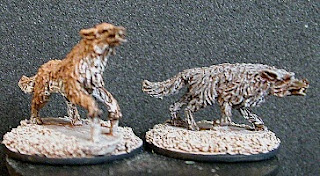Here's a little bit of what goes on behind the scenes of making a miniature.
First someone comes up with an idea and decides, "That would be a great figure." Then the search for a sculptor begins. Often a company already has sculptors with whom they've worked. In my case I sit down and start sculpting, or more often than not, start collecting reference photos from the interweb and then let the project idea simmer for several months.
Once the prototype is complete it is sent to the mold maker. Usually it isn't worth having a master mold made for just one figure so I gather several pieces over a period of months. Sometimes there are other sculptors who have a few pieces they need cast and we can share a mold. For 15mm figures I try to collect between 20 and 24 pieces before I send them off to have a master mold made.
 |
| Completed sculpt |
The mold maker makes what is called a master mold. He presses the prototypes between two disks of rubber under heat and pressure to create a cavity for each model in the mold. He cuts gates (allowing the molten metal to enter the cavity) and vents (allowing air to be expelled from the cavity) into the cured rubber, spins the mold in a casting machine at high speed and pours molten metal into the center. Centrifugal force moves the metal through the mold filling each cavity. When the mold has cooled, the halves are separated and the result is a ring of metal miniatures that are connected by a central sprue.
 |
| Master Cast |
Rather than spin this disk hundreds or thousands of times to create each miniature that will ever be purchased, the mold maker spins it several times (this number varies based on how many figures go into a set for production or how many single figures can be spaced around the mold). These metal masters are used to create production molds that can produce multiples of the same figure. The master mold and figures are filed away against future need. If this production mold wears out the metal master figures can be used to make a new one.
The production casts are usually the figures that actually get sold.
Over the past few years, I've found that not all of my molds need the same number of figures. I end up with more master casts than I actually need to save for making replacement molds. I also end up with masters that i won't be putting into production for several months. I sometimes paint these for my own personal use or use them to fill in missing figures in packs. But I had this crazy idea one day that if I was painting a figure for myself, why not paint several and see if I could sell them to help offset the cost when I was ready to put them in production.
So sometimes I will sell painted pre-production casts. Due to a variety of factors (metal shrinkage, pressure and heat of the mold during casting), the actual bulk of a cast will vary. This is especially noticeable when you view a master cast beside a production cast. The production cast has gone through the mold making process one more time and has been subjected to those variables twice.
 |
| Production compared to master |
The figure on the left is one of the final production casts. The one on the right is a master. Some of the distortion is from the camera viewing the figures at slightly different angles, but the difference in thickness is especially noticeable in the thighs and head.
Enough blab for today. Happy gaming.














